Ten WTF Moments from Classic RPGs
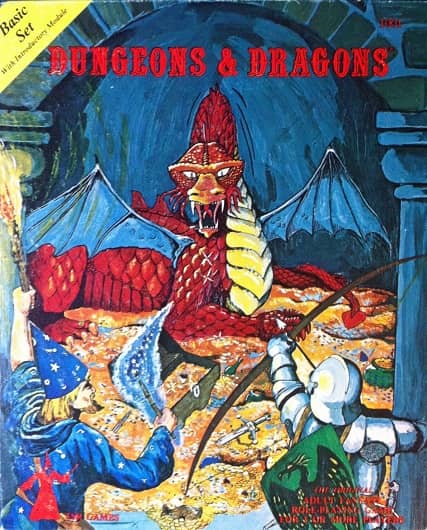 |
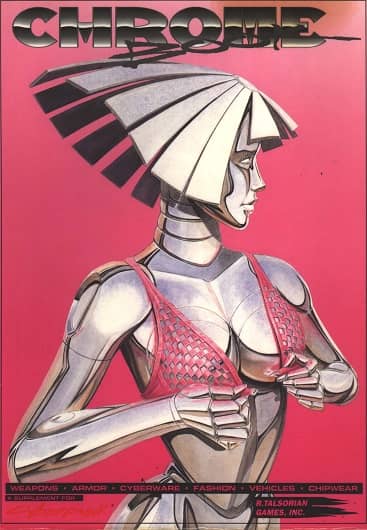 |
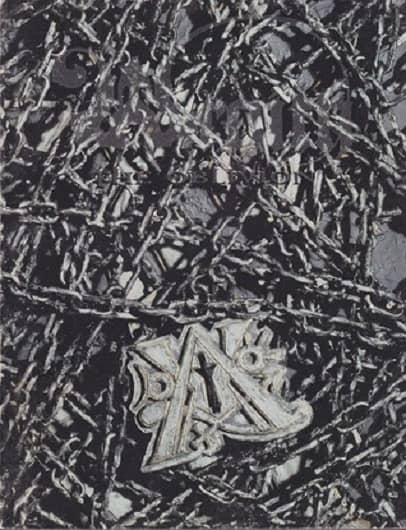 |
By popular demand1, ten WTF were they thinking moments from classic RPGs, which I admit is something of a target-rich environment. I will limit myself to games I’ve actually seen, which means I get to skip past that one.
[1: Well, a couple of people, anyway.]
1) Dungeons and Dragons Basic Set (TSR, 1977)
The 1977 edition of D&D added an orthogonal good vs evil to the law vs chaos morality axis. While humans got freedom of choice regarding where on either axis characters fell, this was not true of some non-human races, which in turn means there are whole races good people are morally obligated to kill when possible. This is by no means unique to D&D but it gets special credit for being the one to establish it as a trope in table-top roleplaying games.
2) Cyberpunk 2020
This may be a misnamed series, because in this case the detail I am very sure I know exactly what the company was thinking.
R. Talsorian’s Cyberpunk (later Cyberpunk 2020) adapted the cyberpunk genre to gaming (and did it without getting the FBI coming down on them like a ton of technically illiterate bricks). As far as the game itself goes, it’s about what one would expect: lots of focus on the surface details of cyberpunk1, not much awareness of any depth in the fiction. Ah, well. Nothing stopping players from adding layers to their game.
The reason I single R. Tal out is because their cover art inspired me to think about how I shelved games. A large fraction of my clientele were women and I didn’t want the first thing they saw when they came in to be something like the cover of Chromebook 1.
I’d like to think this was because I was a particularly insightful but really, it only occurred to me after I overheard two customers complaining about the porn comics another store kept near the register to reduce shrinkage. Cue a bit of reshelving, with the R Tal moved to a side room, and companies like White Wolf and Dreampod 9 in the front.
The reason for the soft core porn art seems pretty obvious: the company thought it would help sell their books, which paints an interesting image of their customer base’s demographics. Sure, the art may potentially alienate a fair swath of the people who see it but that’s really only an issue if you thought the people it puts off were going to buy it in the first place.
[1: And made up slang, which happens to be one of those details that grate on me.]
3) Wraith: the Oblivion
Next on my hit list of “what were they thinking” RPGs; White Wolf1’s Wraith: the Oblivion, in which players played dead people in the afterlife. Not inherently a bad idea, although the first edition was plagued with proof-reading and play-testing issues (1st ed WW games tended to be beta versions). But that isn’t why I want to discuss Wraith. Take a close look at the cover.
Do you see a title?
For reasons that I am sure seemed compelling at 3 AM, White Wolf decided to lean into the whole spectre angle of their game. The title (which you can see if you look very closely) is in glow-in-the-dark ink. If the ink has had time to get charged up, it’s somewhat visible in the dark. A cool effect and just too bad most game stores strongly discourage customers from coming in in the middle of the night when all the lights are out. When the lights are on, the title is essentially invisible.
It happened that the cover matched the colour of the slat wall in my store. Customers who came in looking for Wraith could only find it if I helped them, and I cannot image there were many impulse buys.
1: You might expect a follow-up piece on the White Wolf Magazine/Inphobia transition. I am trying to do only one of these per company and anyway, I can understand why a general interest gaming magazine might want to find a better defined niche, even if the one WW found was “failed experiment.” There have been a lot of good, general interest gaming magazines and very few of them are still around.
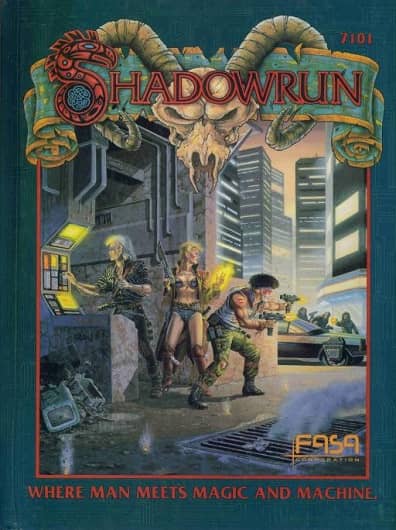 |
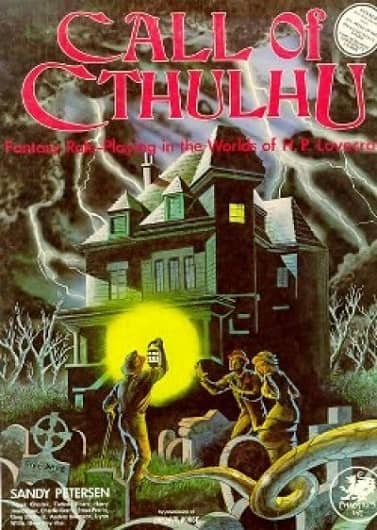 |
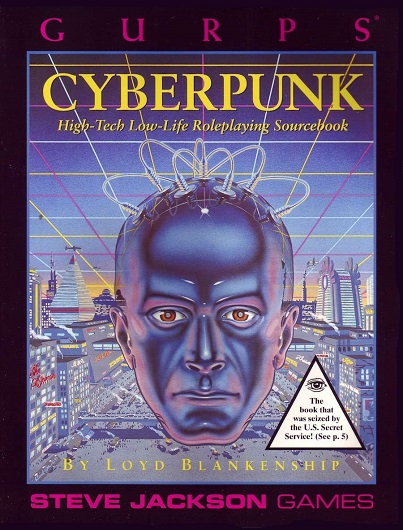 |
4) Shadowrun (FASA, 1989)
Bob Charette, Paul Hume, and Tom Dowd’s 1989 Shadowrun provided FASA with its entry into the flourishing cyberpunk genre. Shadowrun’s twist was to add magic to the setting, much to the irritation of the original cadre of cyberpunk authors, who saw the development as puerile. Of course, magic is only part of the traditional box of world-building props tabletop rpgs use. Another is entrenched racial hatred, which Shadowrun provided in spades: just prior to the return of magic, the US had been pursuing a bitter attempt to find a final solution to the Indian Question, which is why once the Native Americans had access to magic, they carved out an ethnostate for themselves.
Curiously, the idea the US might occasionally go batshit crazy towards one visible minority or another doesn’t seem all that outrageous. The bit where the Native Americans turn out to be magical… Oh, well. In this case they were just ahead of the curve but it is another example of the magical Native American in fiction and part of a greater pattern where colonized people are seen as closer to (super) natural forces1.
What did make my eyebrows go up a bit more was how FASA introduced the traditional fantasy races. One in ten people were suddenly transformed into orks, trolls, elves, dwarves, in a process called “goblinization.” They were immediate social outcasts and when the violence ended, society was divided along traditional rpg lines, with each new variety of human distrusting the others.
The speed and degree to which people who had been until recently unremarkable humans sorted themselves into the traditional fantasy ethnic factions seemed unlikely. After all, why would family members turn on each other just because one of them now had tusks? Granted the existence of anti-vaxxers proves there’s a minority of parents who would rather see their kids dead than unusual.
It belatedly occurs to me the authors might have intended some parallel between how normies react to goblinization and how Americans reacted to AIDS, which was definitely not a mass resolve to cue the disease, at least not until it turned out celebrities could get it.
Note that one in ten people goblinize, which is the same fraction tossed around for the percentage of gay and lesbian people in the general population. Maybe the authors were trying to make a point! That point apparently being “people are dicks.”
[1: Don’t get me started on psychic Celts. ]
5) Call of Cthulhu (Chaosium, 1981)
Sandy Peterson’s 1981 Call of Cthulhu introduced legions of gamers to Cosmic Horror. Despite the tendency of campaigns to end with madness and total party kills, the game was for a long time Chaosium’s most popular product. It has had seven editions and was always well supported, even in its publisher’s most dire moments. As well, a number of top-notch products are available from third parties. If you’ve ever want to play a character who learns too much for comfort before dying horribly – or worse – this is the game for you!
The small fly in the ointment is that the rich game setting has as its foundation H. P. Lovecraft’s deep-seated horror at discovering Italians exist. In fact, the list of races of whose existence Lovecraft approved is very very short, and the list of races he despised was very very long, almost all inclusive. He managed the remarkable trick of being incredibly racist by the standards of America in the early 20th Century, when lynching was frequent, as were anti-Asian immigration laws, and the forced deportation of millions of American citizens for being of the wrong race.
Of course, Lovecraft’s almost universal xenophobia is only obvious if one actually reads his fiction. Or poetry.
There are a number of ways one can deal with problematic source material. One can simply ignore it and hope one’s patrons never read the source material. Vigorous denial is quite popular in some Cosmic Horror critical circles. Game companies lean a different way, which is why one sees tweets like
Let me get this straight. In Fate of Cthulhu we specifically pointed out the racism of HP Lovecraft because well, he was a racist m**********r, and we couldn’t in good conscience ignore that.
and products Harlem Unbound, which acknowledge that particular elephant in the room.
6) GURPS Cyberpunk
Steve Jackson Games’ GURPS RPG itself was never to my taste but their supplements were generally top drawer. Designer Loyd Blankenship’s Cyberpunk proved a bit too convincing. The American Secret Service, demonstrating a level of discernment not seen since the heyday of Dark Dungeons, convinced themselves the game supplement was a blueprint for computer crime. An astounded Steve Jackson Games found itself the subject of a Secret Service raid. It’s all part of the glorious American tradition of handing firearms and sweeping legal powers to people who literally cannot tell fact from fiction.
Although publication was delayed several months, GURPS Cyberpunk did see print. SJG did reasonably well in Steve Jackson Games, Inc. v. United States Secret Service. The affair was part of a series of events leading to the founding of the Electronic Frontier Foundation.
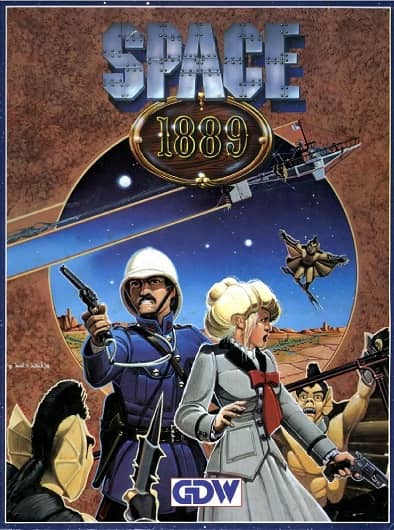 |
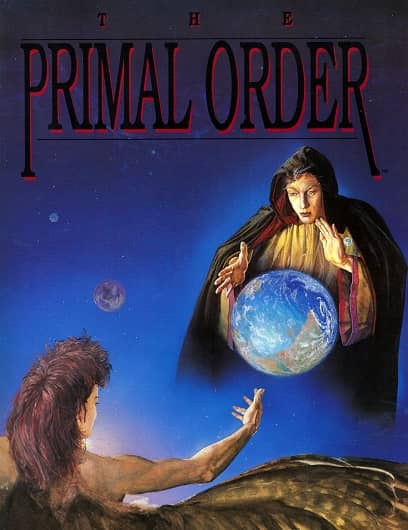 |
 |
7) Space 1889
Frank Chadwick’s 1988 Space 1889 was GDW’s foray into Steampunk roleplaying, although as I recall Jeter had just coined the term “steampunk” and it wasn’t applied to Space 1889. Instead, this planetary adventure RPG, set in a Victorian era where implausible physics handed spaceflight to 19th Century humans, got the tag line “Science Fiction Role Playing in a More Civilized Time.“
Since this was a time when, for example, women in most nations barely had rights, sixty million or so Indians starved to death under the British, the Belgians were busily converting the Congo over to a severed-hand based currency, and the North American settler nations were enthusiastically genociding their way to the West Coast, it does raise the question of from whose perspective the 19th Century could be said to be more civilized, and what precisely there was to be nostalgic about.
8) The Primal Order
Peter Adkinson’s 1992 The Primal Order, was Adkinson’s basement publishing company Wizards of the Coast debut product. The supplement was a fairly comprehensive take on integrating god-level entities into roleplaying campaigns. In fact, it was a bit too comprehensive.
To ensure utility to as broad a swath of gaming as possible, the product included conversion stats for the following systems.
- Advanced Dungeons & Dragons (both 1st and 2nd edition)
- Arduin Grimoire
- Ars Magica
- Chivalry & Sorcery
- Dungeons & Dragons
- GURPS
- HârnMaster
- Hero System
- Palladium Fantasy Role-Playing Game
- Pendragon RPG
- RoleMaster
- RuneQuest
- Shadowrun
- Synnibarr
- Talislanta
- Torg
- Warhammer Fantasy Roleplay
- WarpWorld
The process by which WOTC consulted with the IP owners was somewhat flawed. To quote Adkinson:
We never specifically excluded Palladium from such discussions, it’s just that we only *included* game companies in such discussions if a gaming rep was online, the company was local, or some other convenience arose.
Palladium Games was and is famously protective of their IP, even in circumstances where one might not expect extraordinary diligence to come into play. Silence is consent is not the way to bet with Palladium Games. In fact, Palladium objected quite strongly to WOTC’s use of their IP and sued the infant game company.
It could have been the end of WOTC! Although it wasn’t, thanks in part to a collectable card game they’ve had some success with.
9) SPI’s Loan
Once a dominating figure in table top wargames, by the early 1980s Simulations Publications, Inc. had by means of a series of extremely bold decisions a desperate need for an infusion of cash. Who better to appeal to than the young company who by creating role playing games had contributed to SPI’s increasing challenging environment? SPI borrowed $425,000 from TSR. What could go wrong?
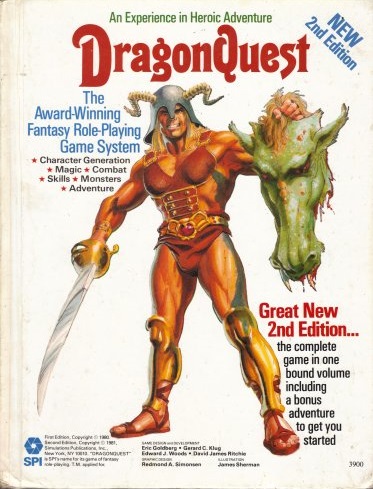 |
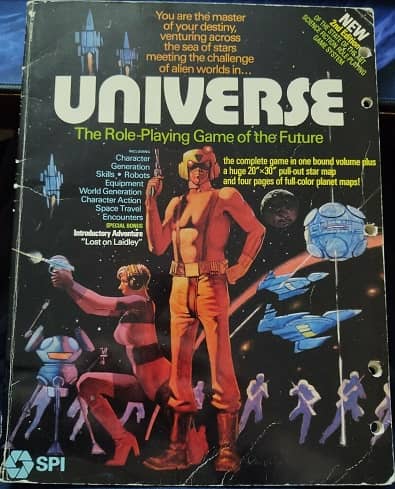 |
I remember sitting in RAFM’s lunch room reading a Gygax Dragon editorial in which if I recall correctly he angrily denounced Origins as an SPI/Avalon Hill anti-TST plot. It may be at least some elements of TSR were not entirely fond of SPI. In any case, SPI did have two RPGs (DragonQuest and Universe) and that made them a competitor.
Two weeks later, TSR called in their loan. SPI could not pay. RIP, SPI.
10) The Great Return of 1996
One of the more horrifying aspects of modern publishing, at least if one is a publisher (or loves books as artifacts), is returns. For reasons going back to the magazine trade, items distributed to the conventional book trade are often returnable for credit against future orders. Generally speaking, for every book that goes home with a reader via conventional book stores1, two or three are returned2.
TSR – I know I said each company only gets one of these but this isn’t really about TSR – had a highly successful fantasy novel line. While TSR had a number of distributors selling directly to game stores, their connection to the conventional book store chains was Random House. The conventional book trade had a seemingly insatiable appetite for TSR’s extruded fantasy product, regardless of author or content. Books flowed out and didn’t come back, which for a company under increasing pressure from a number of directions was a godsend.
What was actually happening (at least in the book trade side of things) was that books and other products were flowing out, a significant fraction was not selling, but rather than being sent back to TSR, they were accumulating in Random House’s warehouses. Why this was happening is an interesting question. In any case, the situation was temporary. Ultimately, what happened was that towards the end of 1996, all of those unsold products were returned. Instead of being returned gradually over time, the books came back in a single, unexpected, fiscally-indigestible six-figure return.
And that (aside from desperate flailing) was that for TSR as an independent company. Within the year, TSR would be a WOTC subsidiary.
[1: Game distributors (like Lion Rampant) and comic distributors (Like Diamond) aren’t locked into this relic of magazine sales and don’t do returns. ]
[2: The marginal cost of printing another mass market paperback is so small it’s not worth sending the actual book back. Instead, the covers get ripped off, bundled and returned. The coverless book is destroyed and discarded.]
Prolific book reviewer and perennial Darwin Award nominee James Davis Nicoll’s work has appeared in Publishers Weekly and Romantic Times as well as on Tor.com and his own websites, James Nicoll Reviews and Young People Read Old SFF (where he is assisted by editor Karen Lofstrom and web person Adrienne L. Travis). He is currently a finalist for the 2020 Best Fan Writer Hugo Award. His last article for Black Gate was Ten Classic Unplayed RPGs.

Bonus WTF moment for SPI — that woman on the cover of Universe looks, at a glance, as if she’s wearing what I can only describe as as reverse bikini.
Joe,
She does! I’ve never noticed that before. And the guy standing next to her, the central figure, looks likes he’s having absolutely zero fun in this whole endeavor.
A bit of cover art I would have flagged had I been aware of it: apparently the original cover art for Perilous Lands (for Avalon Hill’s doomed Powers and Perils) got redone on the orders of editorial because AH wasn’t comfortable with the buxom woman on the cover being stark naked.
Also, I’m now starting to wonder how much the events leading up to the Great Return ultimately distorted the paperback fantasy market — I remember those days when you’d walk into your local Waldenbooks (kids! ask your parents!) in the local shopping mall (kids! ask your parents!) and a significant percentage of the shelf space would be devoted to D&D tie-in fiction and fiction that was emulating D&D tie-in fiction, and if it turns out that the sales were much lower than anybody had realized …
Funny, I was just asked yesterday to run a Dragonquest game. Haven’t done so in 20 years.
“After all, why would family members turn on each other just because one of them now had tusks?”
Considering all the parents who slam doors in the faces of their sons the day after they say, ‘Mom, I think I like other dudes’, not unusual at all.
Hi from Russia
I know about cyberpunk 2020 at 2020 year
Its great game